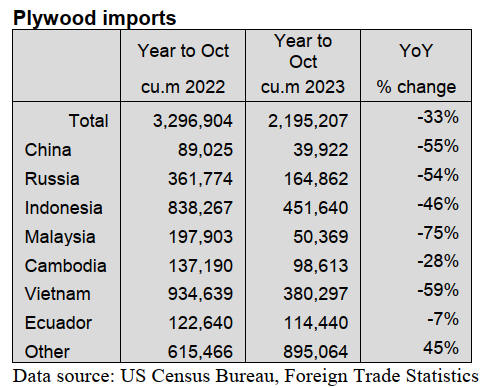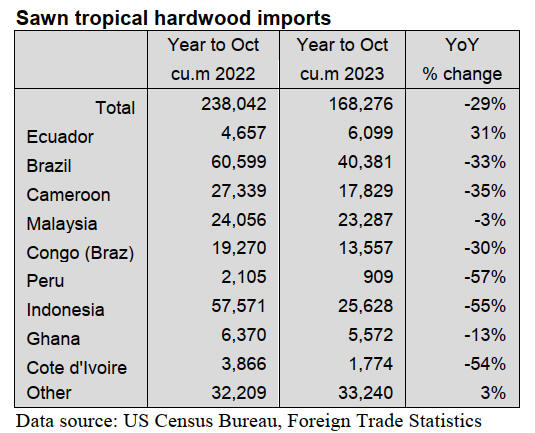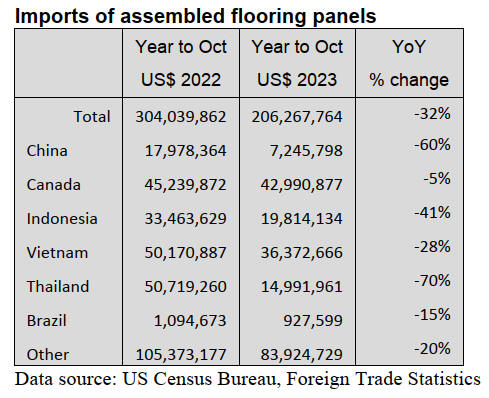|
Report from
North America
Hardwood plywood imports rally
US imports of hardwood plywood rose 78% in October,
rallying back after two months of disappointing declines.
The 320,269 cubic metres of plywood imported in October
was 14% higher than October 2022 imports. Imports from
Russia rose to their highest level of the year, more than
doubling the previous month’s totals, while imports from
China rose 59%.

Imports from Malaysia and Cambodia both rose by around
75% while imports from Indonesia and Vietnam both rose
by about 30%. Despite the surge, hardwood plywood
imports for 2023 remain far behind last year with total
imports from Malaysia, Vietnam, China, and Russia all
less than half of what they were at this point last year.
Total imports are down 33% through October.
Imports of sawn tropical hardwood lag
US imports of sawn tropical hardwood fell slightly in
October, declining 4% from the previous month. The
17,256 cubic metres imported in October was 17% below
the volume imported in October 2022. Imports from the
largest trading partners stayed relatively flat as imports
from Brazil fell 2% and imports from Indonesia gained
2%.
Imports of Keruing rose 85% in October and are up 6%
over last year through the first 10 months of the year.
Balsa imports rose 4% and are up 15% for the year so far.
Imports of all other woods are down for the year with
imports of Ipe, Virola, Jatoba, Teak, and Anigre all
lagging by more than 50% versus last year. Canadian
imports of sawn tropical hardwood rose 10% in October
due to chiefly to imports from Congo/Zaire, which rose to
their highest monthly total in at least 10 years.
Imports from the US and Bolivia also rose sharply while
imports from Brazil fell by 83%. Imports of Iroko were
especially strong this October, propelling year-to-date
numbers for 2024 ahead of last year for the wood.
Imports of Iroko are up 35% over last year while imports
of all other woods remain behind last year’s pace. Total
imports remain down 16% versus last year through
October.

Veneer imports’ rebound, but not as sharply as in most
years
US imports of tropical hardwood veneer nearly doubled in
October, rebounding from their annual September dip with
a 96% gain over the previous month. Imports from China
more than doubled, imports from Cameroon increased
eight-fold and imports from Ghana rose more than ten-
fold.
However, the upward swing was not as robust as in
previous years and import totals actually lost ground
versus last year. Imports went from outpacing last year to
trailing as October 2023 imports trailed October 2022
numbers by 15%. Imports for the year are down less than
1% through October.
Imports of flooring show solid gains
US imports of hardwood flooring rose 15% in October,
fueled by a strong gain in imports from China. Imports
from China were up 66% in October, rising to their highest
level in 20 months. Imports from Indonesia were also
strong, gaining 35% over the previous month. Imports
from Indonesia are ahead of last year by 151% through
October while imports from all countries are up 3% so far
this year.
Imports of assembled flooring panels also moved upward,
rising 16% in October. Here again imports from China
were a factor. Imports from China rose 85% to the highest
level since January. Imports from Thailand were up 78%,
surging to their best month in more than a year. Despite
the gain, imports for the month were down 6% from the
previous October. Total imports of assembled flooring
panels continue to trail 2022 numbers and are off by 32%
versus last year.

Moulding imports slip
US imports of hardwood moulding fell by 8% in October
and was 24% less than that of the previous October.
Imports from chief supplying nations were mostly on the
upswing with imports from Brazil gaining 44%, imports
from Canada up 10%, and imports from Malaysia up 7%.
Imports from China fell 7% and imports from other parts
of the world were down by a combined 24% for the
month.
Imports from Brazil continue to greatly underperform—
even with this month’s percentage gain the US$490k
imported was only one-third that of October 2022. Total
imports for the year so far are down 30% versus las year
with imports from China down 63% through October.

US wooden furniture imports rise to highest level since
January
US imports of wooden furniture rose 12% in October,
rising to their highest level since January. The US$1.75
billion in imports was 13% less than the previous
October’s total. Imports from China advanced 22% in
October while imports from Vietnam, Canada, and
Malaysia all improved by 10% or more.
Despite the gains, year-to-date totals from nearly all
trading partners are far behind their 2022 pace. Total
wooden furniture imports are down 25% versus 2022
through October.

Jobs report shows strong but moderating hiring
Hiring picked up in November as striking auto workers
and actors returned to work and businesses continued to
largely shrug off high inflation and interest rates.
Employers added 199,000 jobs and the unemployment rate
fell from 3.9% to 3.7%, the Labor Department reported.
The report bolsters economists' belief that the Fed will
hold rates steady for the third straight meeting and is likely
done with its sharp rate hikes intended to bring down
inflation. Price increases have been moderating and the job
market has been gradually cooling.
"What we wanted was a strong but moderating labor
market, and that’s what we saw in the November report,"
says economist Robert Frick of Navy Federal Credit
Union.Yet the drop in the unemployment rate gives Fed
Chair Jerome Powell more evidence to not rule out further
rate increases and "push back on the idea that the Fed will
be (cutting rates) soon," says Ian Shepherdson, chief
economist of Pantheon Macroeconomics.
Employment in manufacturing rose by 28,000 in
November, reflecting an increase of 30,000 in motor
vehicles and parts as workers returned from a strike.
Employment in manufacturing has shown little net change
over the year.
Third quarter GDP revise upward
US real gross domestic product (GDP) increased at an
annual rate of 5.2% in the third quarter of 2023, according
to the "second" estimate released by the Bureau of
Economic Analysis. The GDP estimate is based on more
complete source data than were available for the
"advance" estimate issued last month.
In the advance estimate, the increase in real GDP was
4.9%. The update primarily reflected upward revisions to
nonresidential fixed investment and state and local
government spending that were partly offset by a
downward revision to consumer spending. Imports, which
are a subtraction in the calculation of GDP, were revised
down.
|